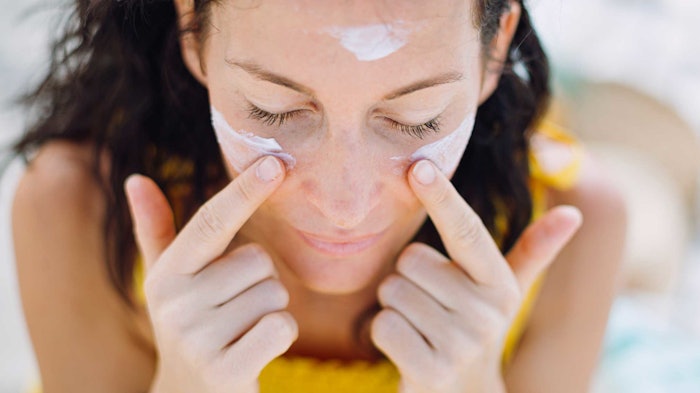
Do-it-yourself (DIY) sunscreens have been a phenomenon in recent years. Currently, TikTok reports 80.5 million posts about homemade natural sunscreens, 44.1 million on homemade sunscreen and 6.9 million of homemade sunscreen with zinc oxide. Instagram has 1.4K posts tagged #DIYsunscreen and 1.2K tagged #homemadesunscreen. Product developers out there are thinking scary, right? Apparently, not as scary to consumers as the mistruths they've heard about sunscreens. While industry experts and scientific communicators continue to reinforce that sunscreen formulating should be left to the experts, the battle rages on for consumer trust.
Log in to view the full article
Do-it-yourself (DIY) sunscreens have been a phenomenon in recent years. Currently, TikTok reports 80.5 million posts about homemade natural sunscreens, 44.1 million on homemade sunscreen and 6.9 million of homemade sunscreen with zinc oxide. Instagram has 1.4K posts tagged #DIYsunscreen and 1.2K tagged #homemadesunscreen. Product developers out there are thinking scary, right? Apparently, not as scary to consumers as the mistruths they've heard about sunscreens. While industry experts and scientific communicators continue to reinforce that sunscreen formulating should be left to the experts, the battle rages on for consumer trust.
See related article on sunscreen testing methods.
Consumer Concerns Over Sunscreens
Last year, Time explored the history of how sunscreens became controversial. It referenced the U.S. Food and Drug Administration's (FDA's) request in 2019 for additional safety data from sunscreen makers. At that time, the FDA deemed zinc oxide and titanium dioxide should be generally recognized as safe and effective but the agency stated it did not have adequate evidence to declare other chemical filters as such. While this simply meant more data was needed, the FDA's request was misinterpreted and "kicked off a flurry of headlines about the potential risks of common sunscreens," Time wrote.
Considering the need for more data, the FDA commissioned studies to assess the safety of organic/chemical sunscreens. It found that sunscreen actives could penetrate the skin and were sometimes present in users' bloodstreams; in some cases, accumulating in the body. While this did not necessarily pose a safety risk, it raised alarm among consumers. Notably, industry experts questioned several facets of the study design and interpretation of the results.
In relation, considering today's chemophobia among consumers and drive for clean and natural products, Consumer Reports points to the way chemical ingredients sound and appear on product labels. "[Consumers] may worry about whether those ingredients are bad for their health (and their kids' health) or if they're potentially harmful to the environment," the source states. This focus on environmental impact has given rise to additional controversy over the alleged (unfounded) impact of chemical sunscreens on coral reefs and emergence of lawsuits over misleading reef friendly product claims.
Adding to these concerns are product recalls due to identification of benzene in sunscreen sprays although notably, at least in the case of Beiersdorf's Coppertone products, the FDA added that daily exposure to benzene at the levels detected "would not be expected to cause adverse health consequences" and that the recall was made "out of an abundance of caution." The case also has been made that some UV filters such as the chemical/organic filter octocrylene cause hormone disruption — although both the European Union and FDA has deemed the ingredient safe at usage levels of up to 10%.
According to a report from McGill University, "Sunscreen Shouldn't be a DIY Project," in 2020, researchers reviewed posts for homemade sunscreen on Pinterest and unfortunately found that nearly all portrayed homemade sunscreen in a positive light, even though more than two-thirds provided inadequate sunscreen protection. "Some offered protection as low as SPF 2, when recommendations are to use a sunscreen of at least SPF 30," explained Christopher Labos, M.D., for McGill.
"Most posts highlighted how easy it was to make sunscreen while offering little information about the dangers of sunburns. Only 3% of posts linked back to a medical website. Despite these shortcomings, many posts were widely shared," Labos added.
It seems the missing elements raising consumer fear over sunscreens, prompting homemade concoctions and even deterring sunscreen use, are:
- Science taken out of context,
- Confusion over risk vs. hazard and
- The industry's voice being drowned out by misinformed influencers.
Expert Concerns Over Sunscreen Avoidance and Misformulation
Fearmongering over sunscreens and concerns about the safety of DIY sunscreens have summoned several experts to weigh in. Harvard Health Publishing stated outright, for example, "Misinformation about sunscreen is common. Don't let myths deter you from using it to protect your skin."
In relation, according to the Personal Care Products Council, the Environmental Working Group's (EWG's) 2024 Sunscreen Guidelines, "mislead consumers into assuming sunscreens are unsafe, thereby jeopardizing public health." The EWG stated that one in four sunscreens out of 1,700 SPF products assessed met the group's standards for ingredient safety and sun protection efficacy.
A Health News report from National Public Radio (NPR) highlighted, "Some TikTok influencers are maligning sunscreen." NPR added, "...[W]hen it comes to sunscreen, there's also a lot of misinformation — false claims that sunscreen is toxic and worse than the sun damage it helps to prevent."
The American Academy of Dermatology also issued a statement by Daniel D. Bennett, M.D., warning that homemade sunscreens are not proven effective and may leave users vulnerable to skin cancer. The Skin Cancer Foundation recently featured an interview with Blair Murphy-Rose, M.D., who proclaimed, "Homemade sunscreen is not safe. When it comes to DIY sunscreens, you don’t know what you’re getting."
Sunscreen Formulation Complexities
Marc Pissavini, Ph.D., an industry sunscreen expert, highlighted the complexities of sunscreen formulating. "Inventing, developing and formulating a sunscreen is an extremely complex exercise that combines concepts from biology, microbiology, photoprotection and formulation," he explained. "It is not a simple recipe where you just mix three or four ingredients."
He added, "The number of tests before commercialization is [also] considerable, covering aspects such as toxicity, irritation, microbiology, and, of course, UV protection (UVB, UVA, photostability, water resistance). Moreover, a sunscreen must also provide a pleasant sensory experience."
Pissavini concluded, "No DIY solution can meet the level of requirements demanded by regulations or authorities. Photoprotection is a serious matter: The number of cancers due to overexposure continues to rise. This must be handled seriously by experienced and qualified experts."
Kelly Dobos, a consulting cosmetic chemist and adjunct professor at the University of Cincinnati, emphasized, "Making a good sunscreen is challenging. It's important to adequately disperse an active like ZnO and a kitchen whisk isn't going to cut it. And all of these ingredients they are using have likely been repacked into those smaller quantities by a reseller who is not going to provide or honor specifications for identity and quality. It's a recipe for disaster."
Cosmetic chemist, sci-comm expert and social media influencer Michelle Wong, Ph.D., (@labmuffinbeautyscience), also called out DIY sunscreen makers on Instagram and YouTube. "This is a really terrible idea," she said. "All DIY sunscreens are. Sunscreens are one of the hardest products to formulate because it's not just about how much zinc oxide you use, it's also about how it's spread out in the product and on your skin." She added that, among other things, it must be tested to ensure it is even dispersed on skin to provide effective coverage.
For many C&T readers, these formulating complexities come as no surprise. Most would agree, it goes without saying that DIY sunscreens are a bad idea. Still, it all comes down to what beauty consumers believe; and many appear to have trust issues when it comes to sunscreens.
Consumer Trust in Sunscreens Wavers
In May this year, CivicScience reported interesting findings in a survey of consumer attitudes about sunscreens:
- Sunscreen use in Americans is higher than it was ten years ago, although it fell from a 79% high in 2022 to 75% in 2024;
- Americans are more concerned about the ingredients in SPF products; 23% of U.S. adults believe certain sunscreens are toxic to their health, up from 17% in 2021; and
- A strong majority (81%) of Americans thing sunscreen is at least "somewhat" effective; 11% think it's not effective at all (8% had no opinion).
Considering the wavering trust in sunscreens, it's no wonder why some consumers have precariously taken sunscreen formulating into their own hands. This makes it all the more important for the voice of reason (and science) to drown out the noise of misinformation.










